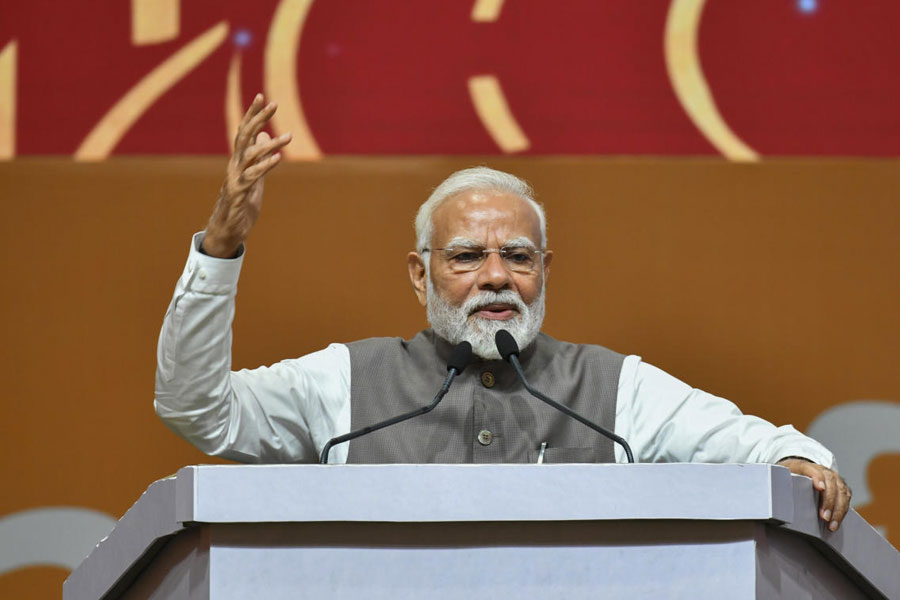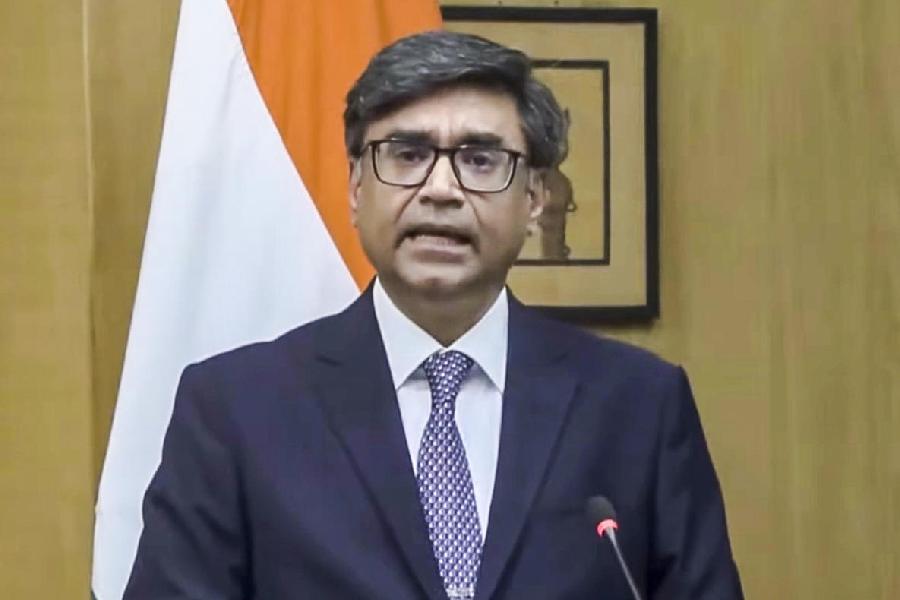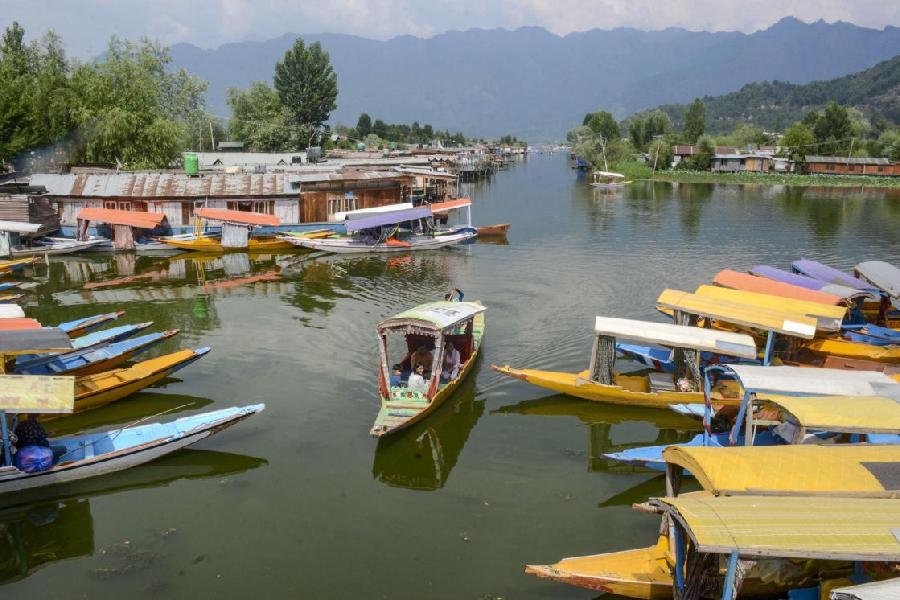 |
| Pramita Mallick and Koushik Sen at Ganesh Pyne’s memorial at CIMA Gallery on Saturday. Picture by Sanjoy Ghosh |
He loved to observe rather than be observed; he enjoyed tutti-frutti at Kwality restaurant in Ballygunge Phari; he bunked oil painting classes for adda at the college canteen; his life became colourful after his marriage; he was a difficult patient.… Ganesh Pyne the man rather than Ganesh Pyne the artist held centre stage at his memorial service at CIMA Gallery on Saturday evening.
 |
Family members, colleagues and critics shared anecdotes about the reticent artist that transformed him from a very private, larger-than-life icon of Indian art to a flesh-and-blood being who loved his space and “saw the skull beneath the skin” as T.S. Elliot had said of the English Jacobean dramatist, John Webster.
“I would ask Ganeshda what would he do if there was no darkness on Earth? Then he would have to create it himself through his work,” said Rakhi Sarkar of CIMA at the start of the programme, referring to Pyne’s theme of darkness.
His fondness for theatre and music is also well-known. Thus the memorial began with singer Pramita Mallick’s rendition of Aakash Bhora. Her songs were interspersed with speeches through the rest of the evening.
Pyne’s son Indranil recounted the days leading to the artist’s death on March 12.
“His death was not expected. A month before his death, he was diagnosed with a lung disease. After three weeks of taking medication, he became his old self and got back his appetite. He started craving for a hearty breakfast and wanted his tutti-frutti at Kwality. Even the night before he died, he had had two egg chops,” said Indranil.
The son’s flashback created a portrait of Pyne the man. “He was by choice a solitary person. That accentuated his creativity. When he started on a tempera work, our entire house would become quiet. No one argued with him,” said Indranil. As the artist started doing more and more sketches on paper, instead of the demanding tempera works, the household breathed easy. The switch seemed to transform Pyne too.
Indranil spoke about how his father had an eye for detail but hated being observed by anyone. “He was the king of his domain. He was a difficult patient, who neglected health checks and once brought a stroke upon himself because of self-medication. Like a king he listened to all but took his own decisions.”
The son also mentioned memorable incidents such as how during a holiday in Puri in 1997, Pyne was very angry that the sea washed away his rubber slipper. When the slipper was washed ashore a little later, his joy was childlike. While visiting his son at Wisconsin, the artist had to face trouble at the airport because he had forgotten to declare the kurta buttons in his pocket. “But he refused to learn from his mistake,” said Indranil.
Pyne would often watch plays. “He refused to accept a guest pass for our group Swapnasandhani’s first play. He insisted on paying for a ticket, much to my embarrassment,” said actor-director Koushik Sen, who recited Abar Ashibo Phire by Pyne’s favourite poet Jibanananda Das. Sen also recited other poems and read an extract from Buddhadeb Basu’s Kaal Sandhya.
Art restorer and critic Arun Ghosh mentioned a Bengali friend of Pyne in Germany, with whom he used to correspond regularly, who died 12 days before him. “Now there are still fewer people in the world who knew the real Pyne,” said Ghosh.
Art critic Mansij Mazumdar, who spoke next, tried to decipher the artist through his works. The former English literature teacher found similarities between the works of Pyne and the metaphysical poets, especially John Donne. “Pyne saw the skull beneath the skin. Skeletons were his main focus. Pyne, I felt, had read the metaphysical poets,” said Mazumdar, who never got the chance to discuss the subject with the artist.
He recited a line from Donne’s poem The Relic: “‘A bracelet of bright hair about the bone’... that could have been Pyne’s work too as he saw the skeletons within. Relic is also the name of a Pyne work. Pyne was as much possessed with death. He hunted for darkness within light. His works stride across the known and unknown,” Mazumdar added.
Artist Ramananda Bandopadhyay felt that one should not search too deep for grammar in Pyne’s works.
“Ganesh Pyne is not lost. He is there through his works. You have to be one with your subject, otherwise you cannot realise the truth. He did just that,” said Bandopadhyay.
Writer Shirshendu Mukhopadhyay, who had interviewed the artist for Desh, recounted the experience. “I was amazed that he had not visited Ajanta, Ellora or the Khajuraho caves, yet his works were as beautiful. He loved the mystery of life, thus the darkness in his pictures. Behind his shyness there was a restlessness that was depicted in his works,” Mukhopadhyay said.
The last to speak on Pyne was his friend, college junior and colleague, artist Jogen Chowdhury. He spoke of Pyne the student, who used to ignore oil painting and was famous among other students since his painting of Rani Laxmibai had been displayed at the Academy of Fine Arts. The painter would stick to saffron kurta and dhoti those days and enjoy adda on films, art and literature at the canteen and New York Soda Fountain. His inspirations then were Abanindranath Tagore, Rembrandt and Paul Klee.
“His late marriage to Meeraboudi changed him. Before marriage, he had told me that he was tired and would work no more. But marriage brought about a change in his life. He went on to work on several more masterpieces, enjoyed a comfortable life full of adda and gaaner ashor in Santiniketan and also started wearing more colourful kurtas,” added Chowdhury as the artist’s widow Meera smiled in the audience.
Chowdhury also spoke about the walls of Pyne’s studio in his Vivekananda Park house that are filled with interesting doodles and scribbles.










